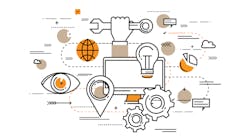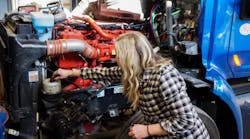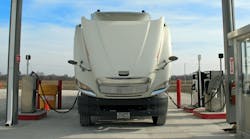Have you heard of multiphysics software?
While this software won’t directly impact your current operations, it is a method that’s being employed by engineers, as OEs continue to develop new strategies to optimize vehicle system design.
I recently read an article in Truck & Off-Highway Engineering (T&OHE) magazine titled “Advanced simulation techniques drive powertrain design,” which discusses continued advancements with designing and testing these vehicle systems.
As vehicle systems become more integrated with one another on the truck, it is imperative engineers consider the interaction between these systems when designing components. To do this, engineers have been using computer simulation and validation tools.
Multiphysics software provides engineers a method of simulating any variety of parameters on a designed system—for example, fluid dynamics, electromagnetics, mechanical operation, etc.—to determine the impact on the system in different settings. In other words, it provides engineers a holistic view of the operation of that system. All of this can now be done without the need to have a prototype and testing facility to physically create these simulations.
Currently, engine and aftertreatment systems are among the areas where this software has proved useful for optimizing system designs. According to T&OHE, testing a diesel engine on multiphysics software allows engineers to make slight changes to both fuel flow and temperature, for instance. Data is then analyzed to see how the system’s operation changes based on the slight changes to those parameters.
“In areas like engines, it’s difficult to further improve fuel economy while meeting emissions requirements. Minute changes in one area often have unexpected consequences, forcing engineers to process a number of design iterations to understand how tweaks of one parameter impact other facets of the design,” according the T&OHE’s article.
Overall, the latest system design technology provides a number of benefits: it saves time, cuts down on the number of resources used to create a physical sample of the product, and allows for “building” and testing multiple design options to optimize fuel efficiency and emissions, to name a few.
Impact on service
The optimization of vehicle system design can have consequences to servicing these vehicles.
Designs of these engine and aftertreatment systems have been optimized for performance when they come off the line, but not necessarily for service considerations once the vehicle spec is completed and it’s driving down the road. What happens when a technician needs to access that system for service?
While it may keep some of the specialty hand tool companies in business, lack of access to vehicle systems is a common frustration when it comes to serviceability.
A challenge I’ve heard from a number of technicians, particularly during my previous time on automotive publications, was the increased challenge of accessing different areas of the vehicle. Especially when it comes to passenger vehicles, look under the hood of any late-model vehicle and it’s like looking at a completed three-dimensional puzzle, with no missing pieces. How do you get to something in the middle of that puzzle and put it back together exactly the same way?
That’s not to mention, after fine-tuning the specs of these systems so specifically there’s hardly room for error, what happens when outside environmental factors start affecting that system?
Think of the number of external factors such as changes in weather conditions—extreme hot or cold temperatures, and precipitation — road vibrations and general wear and tear that occur on those systems. That’s not to mention a human factors such as driver operation, or a technician completing any type of service under the hood.
Step toward vehicle prognostics
It remains to be seen how the optimized design of a system in a controlled setting will translate to real-world use. It will require a continued working partnership with OEs and service providers to make sure vehicles are serviced properly, ensuring optimized operation and maintaining vehicle uptime.
As we cautiously move toward more optimized vehicle designs, it’s important to understand how those optimizations are possible: through data.
Added benefits of this data creation certainly allow fleets a better understanding of pain points within the vehicle, and within the fleet.
The data is already being analyzed at the ground level, with the design of the system. Data recorded through testing these different parameters will ultimately impact the real-world performance of these vehicles. That data can help to solve electrical and diagnostic issues within the system, and plan for system failures before they occur.
All changes come at a cost, requiring industries to adapt. Ours is no exception. We can expect continued technological advancements with vehicle function and design. But, improving diagnostics for the vehicle is one thing. Having the means to complete that repair in a timely and accurate manner is an altogether different challenge that should also be considered.





